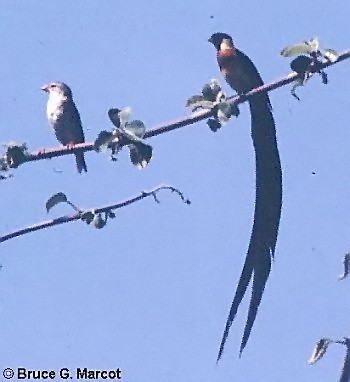Click on the image for a larger version

|
|
Paradise
Whydah: |
|
|
Click on the image for a larger version

|
|
Paradise
Whydah: |
|
Paradise Whydah pair (Vidua paradisaea) |
Credit & Copyright: Dr. Bruce G.
Marcot
|
Explanation: This is a most interesting couple ... a pair of Paradise Whydahs I photographed in eastern Zambia. The male's absurdly long retrices (tail feathers) have likely evolved according to Darwin's concepts of sexual selection, in which some morphological (bodily) traits become extremely exaggerated signals of greater fitness. The short-tailed female, on the left, has paired with this male for now, until he changes his mind, as Paradise Whydah males breed polygamously. What is the specific function of this enormous tail? According to Roberts' Birds of Southern Africa, the male displays with a "bouncing flight upwards at 45-60o, to 20-100 m [65-330 ft] above ground, leveling off and flying with rapid wing beats, broad central retrices raised, long streamers straight out behind, ending in swooping descent to perch; retrices rustle in flight" (Maclean 1993:769). The males display all day, feeding only in the evening, and flocking on twilight perches with neighboring males perhaps in a sort of evening lek. I witnessed this display, and it was remarkable watching the male labor to drag this banner through the sky. His tail and his courtship antics must exact a high metabolic toll. Females and non-breeding males are similar in appearance, but are strikingly different and more drab than the flamboyant male ... a situation called sexual dimorphism, which is common in many birds. Paradise
Whydahs sing with sparrow-like chirping notes and imitate the song of the Melba
Finch. And the female Paradise Whydah is attracted to the Melba
Finch's song. There is adaptive method in this madness, as Paradise
Whydahs are brood
parasites of Melba Honored on various African stamps, Paradise Whydahs are also known as Long-tailed Paradise Whydahs. But by any name, they are a tall tail that is hard to beat! Information: Maclean, G. L. 1993. Roberts' birds of southern Africa. Sixth edition. John Voelcker Bird Book Fund, Cape Town, South Africa. 871 pp. |
Next week's picture: Southern Rata: Blooms Ablaze

Author & Webmaster: Dr.
Bruce G. Marcot, Tom Bruce
Disclaimers and Legal
Statements
Original material on Ecology Picture of the
Week © Bruce G.
Marcot
Member Theme of Taos-Telecommunity